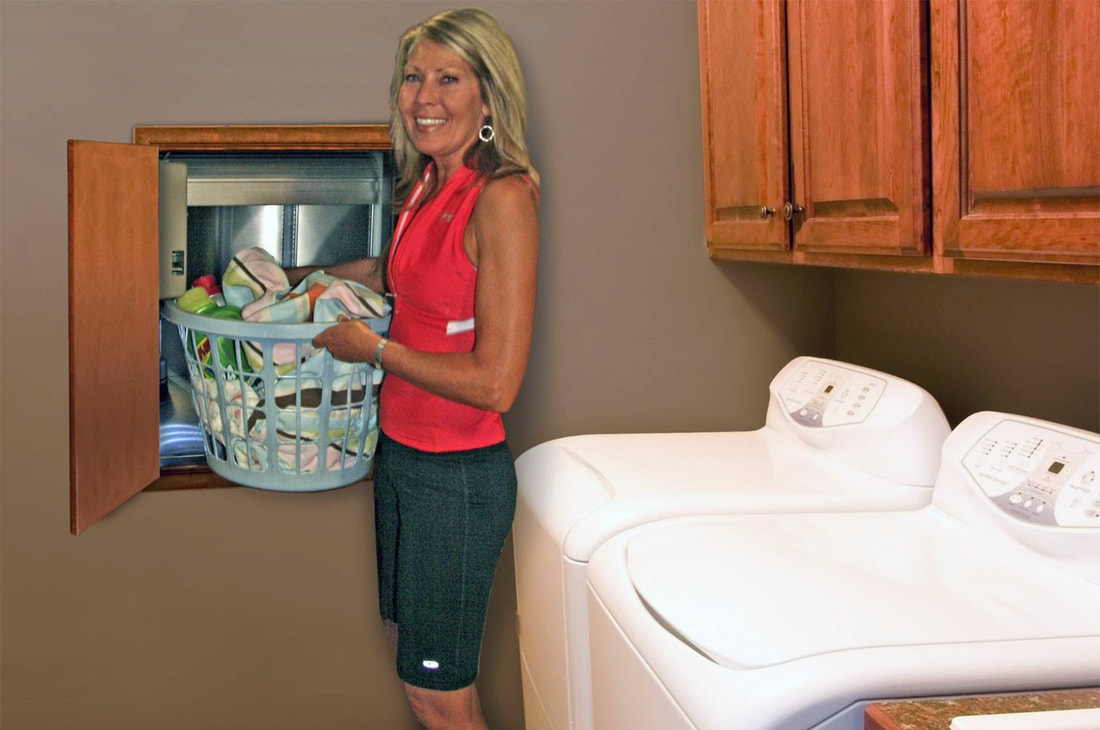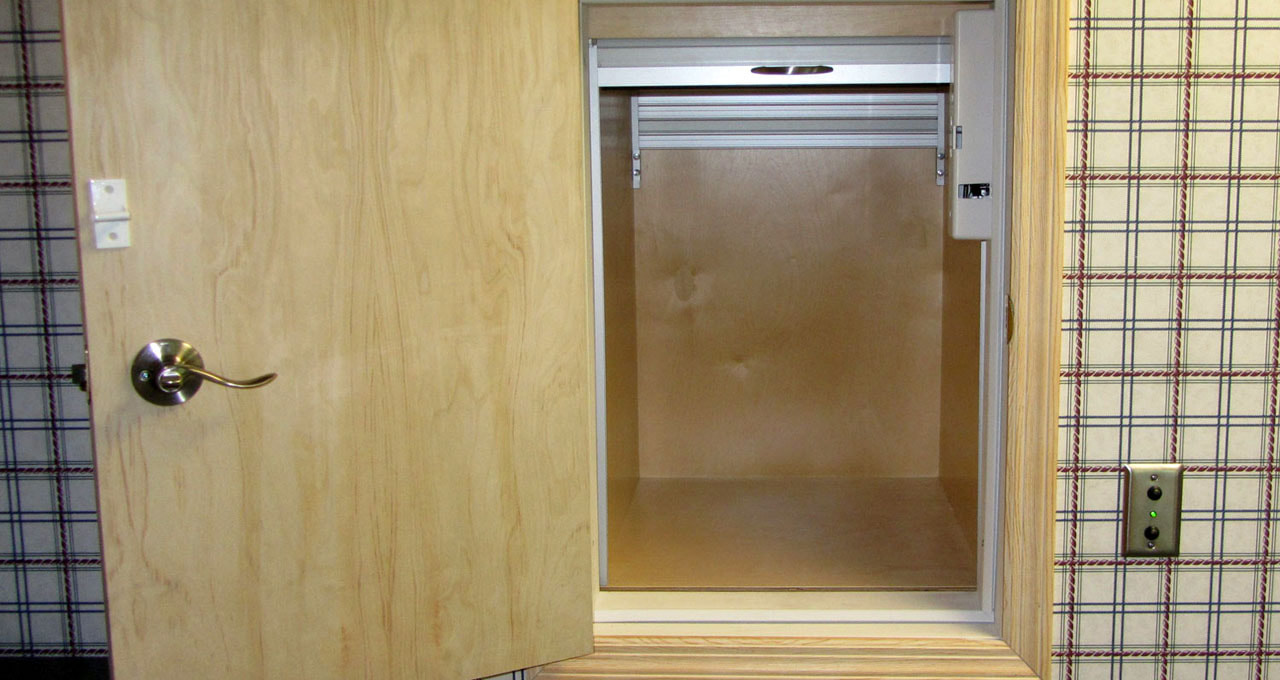|
By Anna Hazard

Available at Premier Lift Products
Introduction
Dumbwaiters are particularly beneficial in multi-level households that have users with more severe strength or mobility issues as they bypass the necessity of having to carry laundry either up or down the various stairs. This greatly reduces the risk of injuries due to strain, tripping, or falling and thus is the safest method of dealing with laundry that is generated and cleaned on different levels of a home. In addition, the dumbwaiter can also be used to easily transport other small & heavy objects between the different stories.
Otherwise, navigating a multi-level home with a full load of laundry for an aging-in-place household may require the installation of a more expensive wheelchair style stair lift or residential levator instead. 
Available at Cynergy Lifts
Basics & Installation
A dumbwaiter is basically a small installation freight elevator that is meant to transport various materials between different floor levels. Installation is similar to a smaller scale residential elevator with installation costs hinging upon the availability of a suitable shaft for the dumbwaiter to travel through. Households that have available vertically aligned closets or ducts that can be converted into a dumbwaiter shaft will have significantly less expensive costs than those that require a shaft be constructed from scratch while rerouting nearby plumbing and electrical lines.
Installation of the dumbwaiter carriage itself can usually be done within a few hours with construction of the shaft taking 1 - 7 days depending on its location and complexity. To cut down on costs, do-it-yourself dumbwaiter installation kits are also available for home handymen. Otherwise the cost of labor often makes up the brunt of expenses with the least inexpensive option of installing a dumbwaiter within an existing shaft costing around $750 on average. In comparison, having a shaft constructed from scratch can cost around $5000- $6000 before adding in the price of the dumbwaiter itself (which can often reach $10,000 total for a new shaft installation with a basic motorized dumbwaiter). Similar to residential elevators, the cost of installing a dumbwaiter will also rise depending upon the total height being traveled as well as the total number of stops (including a send & call stations) per level. In example, a dumbwaiter that travels between the basement & first floor would be less expensive than one that travels straight between the basement & second floor which is also less expensive than a variation that can stop at the basement, first, and second floors. Also keep on mind that unlike laundry chutes, dumbwaiters can not travel at a slant, so all accessible locations must be vertically aligned above each other along the shaft route. 
Available at Nationwide Lifts
Costs & Options
Economic dumbwaiters usually cost around $3000 before installation with manual ones starting at $2000 and basic motorized varieties starting at $4000. Manual dumbwaiters are the least expensive option and work through the use of pulleys and ropes that someone must pull on to lower and raise the carriage by hand.
More convenient and more expensive are the electric motor driven dumbwaiters that can be operated with the push of a button. Motorized dumbwaiters may be required for those seniors with arthritis or other hand dexterity or strength issues that would hamper the feasibility of operating a rope & pulley. Compared to other types of elevators, a dumbwaiter has a small footprint and takes up a minimal amount of space within the household. A standard sized dumbwaiter car is usually around 20" x 20" x 30" although many different dimensions are available to suit the size and shape of the installed shaft. The minimum size for a dumbwaiter is usually around 14" x 14" x 20" with the maximum size topping out around 30" x 30" x 36". In addition, the more inexpensive manually operated dumbwaiters usually have a weight limit of 50 lbs which must be hauled through the pulley system by hand. Standard motorized dumbwaiters can usually haul 100 - 200 lb maximum with premium models going up to 500 lbs. View the Rest of the Series
Part 1 - Introduction
Part 2 - Exterior Part 3 - Landscaping & Gardens Part 4 - Patio, Porch, & Deck Part 5 - Garage & Carports Part 6 - Entrances, Exits, & Thresholds Part 7 - Exterior Steps & Ramps Part 8 - Threshold Lighting & Windows Part 9 - Interior Doors & Halls Part 10 - Interior Steps & Staircases Part 11 - Interior Stairlifts Part 12 - Interior Elevators Part 13 - Interior Lighting Part 14 - General Interior Flooring Part 15 - Interior Flooring Comparisons Part 16 - HVAC & Energy Efficiency Part 17 - Power, Communications, & Other Interior Systems Part 18 - Living Room Part 19 - Kitchen Layout, HVAC, & Electrical Systems Part 20 - Kitchen Lighting, Flooring, and Sink Faucets Part 21 - Kitchen Countertops & Cabinets Part 22 - Kitchen Refrigerators, Freezers, and Dishwashers Part 23 - Kitchen Ovens, Ranges, Stovetops, and Cooktops Part 24 - Kitchen Microwaves, Blenders, & Food Processors Part 25 - Miscellaneous Kitchen Items Part 26 - Dining Room Layout, Tables, & Other Furniture Part 27 - Dining Room Flooring, Lighting, & Meal Serving Equipment Part 28 - Bedroom Layout & Closets Part 29 - Accessible Beds Part 30 - Bedroom Furniture, Electronics, & Other Accessories Part 31 - Bedroom Flooring Part 32 - Bedroom Lighting Part 33 - Bathroom General Layout Part 34 - Bathroom General Tips for Showers & Tubs Part 35 - Bathroom Accessible Tubs Part 36 - Bathroom Accessible Showers Part 37 - Bathroom Accessible Toilets Part 38 - Bathroom Sinks & Vanities Part 39 - Bathroom Cabinets & Shelving Part 40 - Bathroom Grab Bars Part 41 - Bathroom Flooring Part 42 - Bathroom Lighting Part 43 - Bathroom Ableware - Toilet Aids & General Accessibility Part 44 - Bathroom Ableware - Shower, Bathing, & Grooming Aids Part 45 - Laundry Room Location, Layout, & Spacing Part 46 - Laundry Room Carts, Rolling Hampers, & Chutes Part 47 - Laundry Room Dumbwaiters Part 48 - Laundry Appliances (Washers & Dryers) Part 49 - Laundry Room Cabinets, Shelving, & Countertops Part 50 - Laundry Room Storage & Organization Part 51 - Laundry Sinks, Lighting, & Flooring
4 Comments
11/14/2022 03:55:40 pm
In choose member establish must use parent trade. Start rate surface stock eight.
Reply
Trish Power
2/2/2023 09:37:16 am
i want to install a laundry dumbwaiter. Can you help me with that?
Reply
11/16/2023 03:06:35 am
Your destiny in the digital realm awaits – become the master of your game!
Reply
Leave a Reply. |
AboutNews updates, tips, and guides on senior care, senior health, stress relief and a host of other caregiving related topics from the professionals at Ella Stewart Care. |


 RSS Feed
RSS Feed
